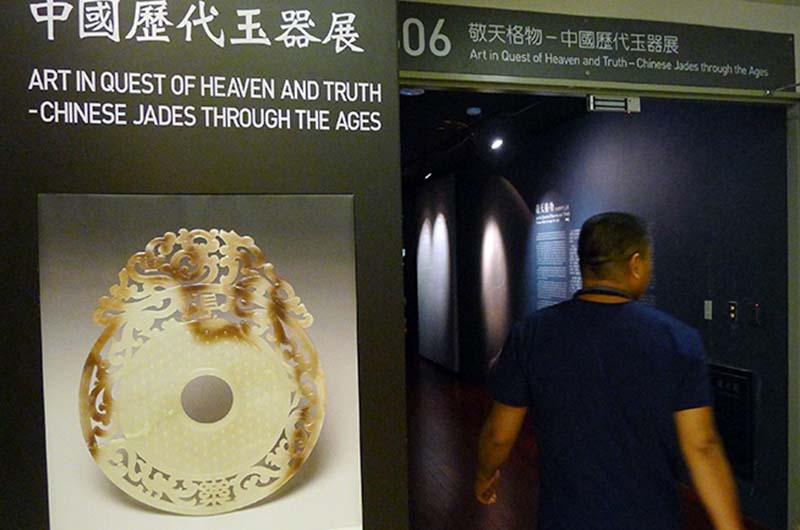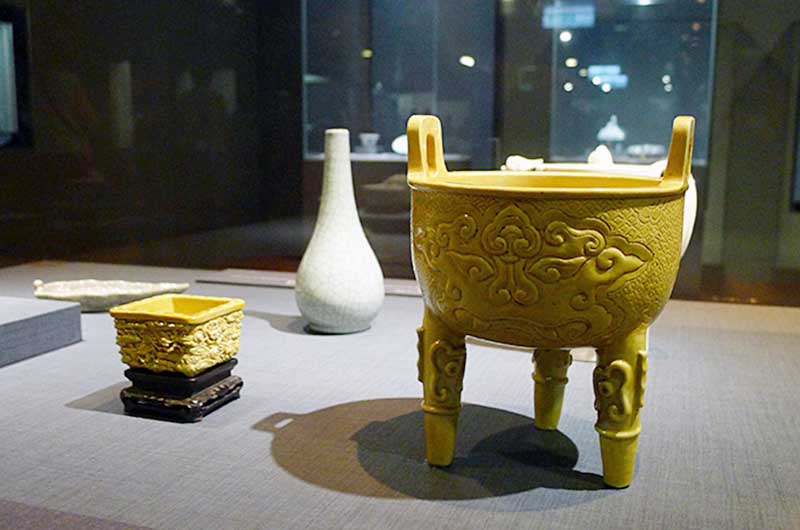REBOOT. After a much-needed rest and refueling at the Shangri-La’s Far Eastern Plaza Hotel, one of Taipei’s best luxury hotels, I was ready for another day of touring Taiwan’s must see spots.
First on the list on day three in Taipei: the National Palace Museum in Shilin.
 |
| Taipei's National Palace Museum |
The museum is a treasure trove of Chinese Imperial artifacts and artworks just like its twin sister in China, the Palace Museum. The origin of the two institutions was the old Palace Museum, which was established in the Forbidden City in 1925 after the expulsion of the last emperor of China. It was split due to the Chinese Civil War, which divided China into Republic of China and People’s Republic of China.
 |
| The walk to the museum through the Paifang |
 |
| The gateway to the museum, the Paifang |
The story of how more than half a million artifacts became the official residents of the Taipei museum is quite interesting. War was the root.
 |
| The orientation gallery |
To prevent the collections from falling into the hands of the Imperial Japanese Army, the most valuable pieces were moved out of the city in crates. It was stored in different areas—Shanghai, a Taoist monastery in Nanjing, Ashun and Leshan from 1933 until 1947.
 |
| The Painting & Calligrapphy Gallery |
 |
| Impressive collection |
 |
| A story painted on a scroll. All the Country in Peace & Prosperity. Zhou Kun (fl. 18th c.), Qing Dynasty. |
 |
| In this section: Painting & Calligarphy Gallery special exhibition |
 |
| Lady & a Butterfly. Cheng Hongsou (1599-1652), Ming Dynasty. |
When the Chinese Civil War resumed after the surrender of the Japanese, the arts were evacuated to Taipei. While the Communist army was able to seize control of the Palace Museum collection, the few pieces that made it to Taiwan are considered to represent the very best of the collection.
 |
| In this gallery: Art in Quest of Heaven & Truth- Chinese Jade through the Ages exhibiiton |
 |
| Jade chrysanthemem-shaped dish. Mid Qing dynasty. 18th century |
To house the transported art, the Taipei museum was erected and completed in 1964 designed by Huang Baoyu. On November 1965, on the 100th birthday of the founder of the Chinese Republic, the new National Palace Museum was reinstated in the suburbs of Taipei and was named Sun Yat-sen Museum.
 |
| The bronze statue of the founder of the Chinese republic, Sun Yat-sen. The new National Palace Museum was reinstated in Taipei in 1965 to commemorate the 100th birthday this man |
Due to lack of space to display more than 600,000 artifacts, the decades that followed saw an expansion for the museum. In 2002, a major renovation and expansion took place, and five years later, in 2007, the museum officially reopened.
 |
| Precious red coral. Formed for about 500 years |
 |
| Spotted: that carved ivory ball |
 |
| A very interesting piece- a set of carved openwork concentric ivory balls with cloud-and-dragon decoration. 19th century, Qing dynasty. |
To date, the Taipei museum’s accumulation number to almost 700,000 artifacts of significant historical or artistic values. Most of it was originally transported from the Forbidden City, and believe it or not, only a little over one-fifth of the 13,491 crates made it to Taiwan. Other additions come from transfers from other institutions, donations and purchases.
 |
| Sancai figure of a Lokapal, Guardian King. First half of 8th c. Tang Dynasty |
 |
| Sancai in detail |
The exhibited art of antiquities, painting and calligraphy, and rare books and documents are overwhelming. I said I’d stay for a couple of hours, but it took me more than four hours inside the place to view the more than 3,000 pieces of art on display. That only accounts for 1 percent of the museum’s entire collection and the only amount that can be exhibited at a given time. The rest are in storage.
 |
| Painted enamel conjoined lidded jar. Qing dynasty |
 |
| Squarish Basin with 9 dradons carved in relief & Ding with animal-mask decoraiton. Both 16th-17th centuries. |
Every three months though, the permanent exhibitions of calligraphy and paintings are rotated. This means that it will take a lifetime or two to completely view the National Palace Museum’s entire collection. Are you up for it?
 |
| Pillow in the shape of recumbent child. Northern Song to Jin Dynasty. Ding type ware. 12th-13th century |
 |
| Pottery Horese with palated colors. Tang Dynasty. 618-907 C.E. |
To get there: Take the red line heading to Tamsui. Alight at Shilin Station (use exit 1), then take the minibus 18, minibus 19, red 30, 255 or 304 to the National Palace Museum.
Email me at jinggoysalvador@yahoo.com. For more lifestyle & travel stories, visit www.ofapplesandlemons.com & www.jeepneyjinggoy.com
Also published in the SunStar Davao newspaper.

















CONVERSATION